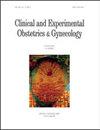Analyzing the detrimental effects of female chronic hepatitis B virus DNA on ovarian reserve function and results of in vitro fertilization
IF 0.6
4区 医学
Q4 OBSTETRICS & GYNECOLOGY
引用次数: 1
Abstract
Background: To evaluate both the impact of hepatitis B virus (HBV)-DNA copies in women with HBV infection on the ovarian reserve function and outcomes of in vitro fertilization (IVF).Methods: We conducted a retrospective study on a total of 9927 couples undergoing their first IVF cycle. After filtering, 1570 couples (546 HBV-seropositive women and 1024 HBV-seronegative women whose partners were HBV-seronegative) failed to meet inclusion criteria. According to the HBV-DNA titers in serum, the HBV-seropositive group was divided into three groups: DNA-high copy group (n = 139), DNA-low copy group (n = 241), and DNA-negative group (n = 166). All patients underwent controlled ovarian hyperstimulation using the long downregulation protocol followed by IVF. Results: Compared with the HBV-negative group, HBV-positive women with high DNA copy exhibited lower antral follicle count (AFC) (11.9 ± 4.3 vs 13.3± 3.2), lower number of oocyte retrieved (9.2± 5.7 vs 13.1± 6.1), larger proportion of AFC<8 (7.9% vs 3.1%) and anti-mullerian hormone (AMH) <2 μg/L (8.6% vs 4.3%). Both high-DNA copy and low-DNA copy groups exhibited a lower fertilization rate (70.9% and 72.5% vs 75.1%), lower high-grade embryo rate (51.5% and 53.8% vs 56.9%), lower implantation rate (31.3% and 32.7% vs 38.5%), lower clinical pregnancy rate (40.3% and 42.3% vs 49.6% per cycle with OR; 45.5% and 48.8% vs 56.8% per cycle with ET) than the HBV-negative group. Moreover, a higher early abortion rate (19.6% and 15.7% vs 7.1%) was observed in the above two groups. Conclusion: HBV-DNA may have a negative effect on women’s ovarian reserve function which in turn results in poor fertilization rate, clinical pregnancy rate and high early abortion rate in IVF treatment.女性慢性乙型肝炎病毒DNA对卵巢储备功能及体外受精结果的影响分析
背景:评价乙型肝炎病毒(HBV)-DNA拷贝对感染HBV妇女卵巢储备功能和体外受精(IVF)结果的影响。方法:对9927对首次IVF周期的夫妇进行回顾性研究。经筛选,1570对夫妇(546名hbv血清阳性妇女和1024名hbv血清阴性妇女,其伴侣为hbv血清阴性)未符合纳入标准。根据血清中HBV-DNA滴度,将hbv -血清阳性组分为dna高拷贝组(n = 139)、dna低拷贝组(n = 241)和dna阴性组(n = 166)。所有患者均采用长期下调治疗方案控制卵巢过度刺激,然后进行体外受精。结果:与hbv阴性组相比,高拷贝hbv阳性妇女的窦卵泡计数(AFC)(11.9±4.3比13.3±3.2)较低,取卵数(9.2±5.7比13.1±6.1)较低,AFC<8的比例(7.9%比3.1%)较大,抗苗勒管激素(AMH) <2 μg/L的比例(8.6%比4.3%)较大。高拷贝组和低拷贝组受精率较低(70.9%和72.5%比75.1%),高级别胚胎率较低(51.5%和53.8%比56.9%),着床率较低(31.3%和32.7%比38.5%),临床妊娠率较低(40.3%和42.3%比49.6%)。45.5%和48.8% (ET组为56.8%)比hbv阴性组高。两组早期流产率分别为19.6%和15.7%,高于7.1%。结论:HBV-DNA可能对女性卵巢储备功能产生负面影响,从而导致IVF治疗中受精率低、临床妊娠率低、早期流产率高。
本文章由计算机程序翻译,如有差异,请以英文原文为准。
求助全文
约1分钟内获得全文
求助全文
来源期刊
CiteScore
0.50
自引率
0.00%
发文量
241
审稿时长
1 months
期刊介绍:
CEOG is an international, peer-reviewed, open access journal. CEOG covers all aspects of Obstetrics and Gynecology, including obstetrics, prenatal diagnosis, maternal-fetal medicine, perinatology, general gynecology, gynecologic oncology, uro-gynecology, reproductive medicine, infertility, reproductive endocrinology, sexual medicine. All submissions of cutting-edge advances of medical research in the area of women''s health worldwide are encouraged.

 求助内容:
求助内容: 应助结果提醒方式:
应助结果提醒方式:


